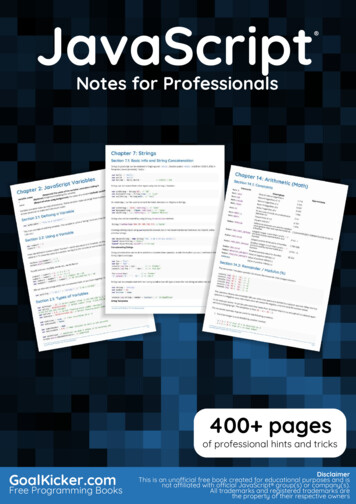
Transcription
Angular 2 Angular 2 Notes for ProfessionalsNotes for Professionals200 pagesof professional hints and tricksGoalKicker.comFree Programming BooksDisclaimerThis is an uno cial free book created for educational purposes and isnot a liated with o cial Angular 2 group(s) or company(s).All trademarks and registered trademarks arethe property of their respective owners
ContentsAbout . 1Chapter 1: Getting started with Angular 2 . 2Section 1.1: Getting started with Angular 2 with node.js/expressjs backend (http example included) . 2Section 1.2: Install angular2 with angular-cli . 7Section 1.3: Getting started with Angular 2 without angular-cli . 10Section 1.4: Getting through that pesky company proxy . 14Section 1.5: Keeping Visual Studios in sync with NPM and NODE Updates . 15Section 1.6: Let's dive into Angular 4! . 16Chapter 2: Components . 20Section 2.1: A simple component . 20Section 2.2: Templates & Styles . 20Section 2.3: Testing a Component . 21Section 2.4: Nesting components . 22Chapter 3: Component interactions . 24Section 3.1: Pass data from parent to child with input binding . 24Section 3.2: Parent - Child interaction using @Input & @Output properties . 30Section 3.3: Parent - Child interaction using ViewChild . 31Section 3.4: Bidirectional parent-child interaction through a service . 32Chapter 4: Directives . 35Section 4.1: *ngFor . 35Section 4.2: Attribute directive . 36Section 4.3: Component is a directive with template . 36Section 4.4: Structural directives . 36Section 4.5: Custom directive . 36Section 4.6: Copy to Clipboard directive . 36Section 4.7: Testing a custom directive . 38Chapter 5: Page title . 40Section 5.1: changing the page title . 40Chapter 6: Templates . 41Section 6.1: Angular 2 Templates . 41Chapter 7: Commonly built-in directives and services . 42Section 7.1: Location Class . 42Section 7.2: AsyncPipe . 42Section 7.3: Displaying current Angular 2 version used in your project . 43Section 7.4: Currency Pipe . 43Chapter 8: Directives & components : @Input @Output . 44Section 8.1: Angular 2 @Input and @Output in a nested component . 44Section 8.2: Input example . 45Section 8.3: Angular 2 @Input with asynchronous data . 46Chapter 9: Attribute directives to a ect the value of properties on the host node byusing the @HostBinding decorator. . 48Section 9.1: @HostBinding . 48Chapter 10: How to Use ngif . 49Section 10.1: To run a function at the start or end of *ngFor loop Using *ngIf . 49Section 10.2: Display a loading message . 49Section 10.3: Show Alert Message on a condition . 49
Section 10.4: Use *ngIf with*ngFor . 50Chapter 11: How to use ngfor . 51Section 11.1: *ngFor with pipe . 51Section 11.2: Unordered list example . 51Section 11.3: More complext template example . 51Section 11.4: Tracking current interaction example . 51Section 11.5: Angular 2 aliased exported values . 52Chapter 12: Angular - ForLoop . 53Section 12.1: NgFor - Markup For Loop . 53Section 12.2: *ngFor with component . 53Section 12.3: Angular 2 for-loop . 53Section 12.4: *ngFor X amount of items per row . 54Section 12.5: *ngFor in the Table Rows . 54Chapter 13: Modules . 55Section 13.1: A simple module . 55Section 13.2: Nesting modules . 55Chapter 14: Pipes . 57Section 14.1: Custom Pipes . 57Section 14.2: Built-in Pipes . 58Section 14.3: Chaining Pipes . 58Section 14.4: Debugging With JsonPipe . 59Section 14.5: Dynamic Pipe . 59Section 14.6: Unwrap async values with async pipe . 60Section 14.7: Stateful Pipes . 61Section 14.8: Creating Custom Pipe . 62Section 14.9: Globally Available Custom Pipe . 63Section 14.10: Extending an Existing Pipe . 63Section 14.11: Testing a pipe . 63Chapter 15: OrderBy Pipe . 65Section 15.1: The Pipe . 65Chapter 16: Angular 2 Custom Validations . 68Section 16.1: get/set formBuilder controls parameters . 68Section 16.2: Custom validator examples: . 68Section 16.3: Using validators in the Formbuilder . 69Chapter 17: Routing . 70Section 17.1: ResolveData . 70Section 17.2: Routing with Children . 72Section 17.3: Basic Routing . 73Section 17.4: Child Routes . 76Chapter 18: Routing (3.0.0 ) . 78Section 18.1: Controlling Access to or from a Route .
import { bootstrap } from '@angular/platform-browser-dynamic'; import { AppComponent } from './app.component'; bootstrap(AppComponent); We're importing the bootstrapfunction and AppComponentclass, then using bootstrapto tell Angular which component to use as the root. Step 8 It's time to fire up your first app. Type.File Size: 1MBPage Count: 232









